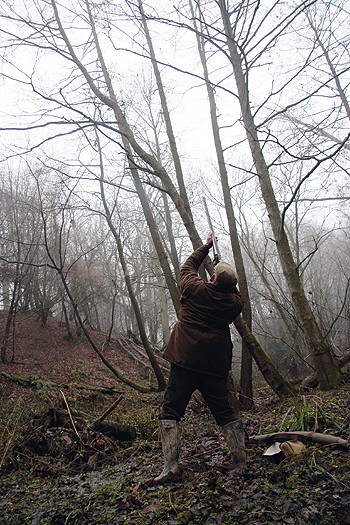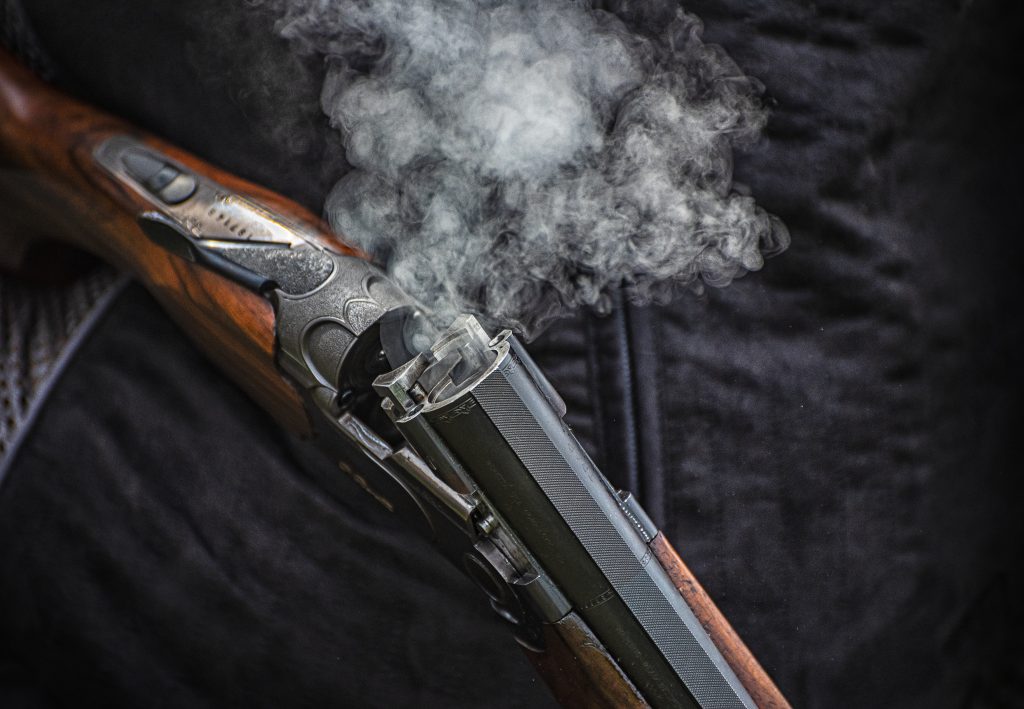Win CENS ProFlex DX5 earplugs worth £1,149 – enter here
The Owley shoot
<strong>Selena Masson joins one conservation-conscious shoot in Kent that is hoping to restore its grey partridge population for the next generation</strong>

The weather was against the Owley shoot achieving its usual bag when I visited on 30 December. ?The whole of Kent is under thick fog and there is absolutely no wind today,? said keeper Phil Ford ominously, as he invited each of the Guns to draw a peg number.
Now in its fourth season, the 2,000-acre shoot is situated on the edge of Romney Marsh, in Wittersham, Kent. Shoot owner Tim Piper explained that his syndicate was originally formed for fathers, sons and daughters. ?Over the years, many youngsters have learned to shoot here,? he said. ?As most of them are now at university, they tend to shoot only at Christmas time, so it is great to see so many of them here today. However, I am hopeful that my two young daughters, Millie and Lucy, will start shooting when they?re a little older.?
By 9am, the muddy farm car park was bustling with an imposing army of beaters. Despite the inclement weather, more than 40 people had turned up to offer their services. ?Though we do not offer a monetary incentive, we have never struggled to attract a large number of beaters,? said Phil, adding that they are always well catered for at lunchtimes. ?The Guns also pay for a meal in a local restaurant at the end of the season by way of saying thank you,? he told me.
Excellent driven shooting
The inaugural drive of the day, known as Pond Drive, saw the Guns nestled in a valley that was originally carved out by an estuary. ?Before the great storms of the 15th century silted up the river Rother, the area was linked to the sea and became an important shipbuilding centre and trading port,? explained Tim. The result of the storms is dramatic topography that lends itself brilliantly to driven pheasant and partridge shooting.
Standing behind Dave Hawkes on peg four, I watched the beaters split into two teams and push the maize covercrop towards a corner flushing point. As intended, the birds fanned out in every direction, providing sport for each of the Guns. Dave seemed to have found himself on the best peg, as birds poured out of the blackthorn hedge in his direction. He used his Browning B25 B2 with absolute precision, expertly shooting several right-and-lefts. Dave?s neighbour Rex Smith, a local sheep farmer, had equally good sport throughout the drive. I spied his 100-year-old Lang side-byside crumpling numerous birds as they attempted to race back to the release pen.
The next drive, Chapel Bank, was a wild bird drive. Conservation-conscious Tim explained to me why he is so committed to Natural England?s Higher Level Stewardship scheme, which he signed up to in 2007. ?We leave 6m borders around all our arable fields and have planted seven miles of new hedges,? he said. ?Not only does this benefit local wildlife, but it boosts the number of wild gamebirds we have on the shoot.? On this part of the farm, Tim only releases English partridges. ?These are strictly not for shooting,? he said. ?This is the second year that I have released 80 greys. I am determined to help this enchanting English bird to return to its former glory.?
As the Guns made their way across a muddy field of winter wheat, Phil pointed out the swirling rooks in the covercrop. I could not believe my eyes ? there must have been hundreds of them. ?We are plagued with corvids,? he said, shrugging. ?Unfortunately, none of the rookeries are on my land. Local game chef Mark Gilchrist shoots a few of the rooks in the summer, but we need to make a concerted effort to control their numbers next year, as they decimate our maize and eat birds? eggs.?
On peg No 3, Malcolm Batt was dry mounting his 12-bore Miroku in readiness for the drive. The beaters again split into two teams and worked the covercrop from opposite ends to force the birds to flush in the middle. ?As these birds are wild, this drive can be a little unpredictable,? whispered Malcolm, as he watched his wife Sue, daughter Lizzie and Labrador Sweep walk up through the maize and wild flower mix.
To his right was Phil Ford?s eldest daughter, Megan, who has been shooting for two years. ?In the summer, I really enjoy helping my father to feed the pheasants and learning about how to run a shoot,? she said, as we waited expectantly for the first birds to flush. Then, suddenly, a covey of eight French partridges broke from the cover, giving the Guns on Megan?s right some challenging sport. As the two beating teams drew closer together, several waves of pheasants started to tower above the Guns. Undeterred by their height, I spied both Malcolm and Megan shoot several birds. The action did not stop there. On the farthest peg, Phil Bartholomew also shot a speeding hen bird dead in its tracks with his 16-bore, before his diminutive Border terrier, Fred, retrieved it to his waiting hand.
Lunch was held in a grain store back at the farm headquarters, where Mark Gilchrist?s legendary game pies and Gun John Walsh?s sweet home-made sloe gin were devoured and sipped respectively. Picker-up Gary Tate was noticeably absent from the lunch room, as he was still out with his chocolate Labrador, Brontë, looking for a pricked bird. This had unintended consequences: ?My father has the car keys, so we can?t get our packed lunch out of our car and I?m starving,? moaned Gary?s nine-year-old son, Sam, as he tucked in to a piece of pie. Luckily for Sam, Gary turned up with the pricked bird and the family?s picnic hamper just as the pie ran out.
The postprandial drive was Pen Wood, which once again utilised the ancient estuary?s riverbanks. Twice Hélice world champion Howard Batt said he had high hopes for this drive. ?This is the first time this season we have pushed the pen, so we are hoping that the birds will behave as expected,? he said, adding that the shoot has only one pen. ?It covers an area of about one and a half acres, however.?
On that note, Tim blew his horn to warn everyone that we would be setting off in five minutes. The Guns loaded up in the farm?s 4×4 trucks and I sat next to agricultural student and Gun Will Barnes. ?There are three of us sharing one peg today, so it is my turn to shoot the next drive,? he said. ?The fathers tend to beat when their children are back at home from university, which suits us perfectly.?
For this drive, I stood behind keen Shot John Walsh and picker-up Pete Collick. With impressive accuracy, John managed two right-and-lefts and shot several birds with his first barrel, before Pete?s yellow Labrador, Jess, retrieved them one by one. By now, the fog was thicker than ever, making it tricky to see where the birds were flushing from. Unfazed, each of the Guns contributed to the bag and Pen Wood proved its worth as a drive.
A new challenge
The next drive was unlike the others. For Rush Green, the Guns were placed at the bottom of a gulley inside woodland, meaning the birds passed overhead at around 70ft. Gun Tom Chapman said he relished the challenge that this drive
presented. ?This is snap shooting at its best,? said the 17-year old student, beaming. Through the canopy, Tom managed clean kills on four birds that many Guns would not have even attempted. ?I have been roughshooting quite a lot, so I guess I have learned to react quickly,? he said. Between shots, Tom explained that he is the only person who shoots at his school: ?Despite all the campaigns by BASC and the Countryside Alliance, there are still not enough young people shooting, in my opinion. I recently had to debate the merits of hunting for sport for an assignment and I achieved an A*, even though my teacher is anti-shooting. I hope that I helped my classmates to see the true value of fieldsports.?
As we made our way through the dense fog to the last drive, known as Timber Wood, I noticed some state-ofthe-art hoppers along a fence line. Tim explained that his late father, Michael, had designed and patented them. ?We make the hoppers here on the farm and now sell around 2,000 a year,? he said, adding that a special pecking bar means the feeder is operated by the birds, which results in minimal waste. ?Unlike traditional hoppers, which leave a lot of food on the ground, this design only dispenses a few pellets at a time,? he said.
For this drive, I accompanied Rex Smith to his peg. As we waited in the damp fog, a roding woodcock danced down the line, but remained untouched by the Guns. ?Tim likes to preserve the woodcock and wildfowl on the shoot,? explained Rex. In the far distance, the beaters? tapping was becoming louder. Like all the Guns on the Owley shoot, Rex displayed a flair for shooting. Without ever discharging his second barrel, he felled only the highest birds. Sadly, his impressive shooting was left unappreciated, as fog made it tricky to see down the line of Guns.
Achieving a balance
Tim?s commitment to conservation and teaching younger generations about shooting has resulted in a syndicate that has a judicious and considerate attitude towards the sport. This group does not release more birds than is sustainable for the local area and does not seek to make a profit ? its members seem to have achieved an equilibrium that many syndicates strive for. Owley is a model shoot with exemplary values and will hopefully instill good husbandry in many more generations to come.
Related Articles
Get the latest news delivered direct to your door
Subscribe to Shooting Times & Country
Discover the ultimate companion for field sports enthusiasts with Shooting Times & Country Magazine, the UK’s leading weekly publication that has been at the forefront of shooting culture since 1882. Subscribers gain access to expert tips, comprehensive gear reviews, seasonal advice and a vibrant community of like-minded shooters.
Save on shop price when you subscribe with weekly issues featuring in-depth articles on gundog training, exclusive member offers and access to the digital back issue library. A Shooting Times & Country subscription is more than a magazine, don’t just read about the countryside; immerse yourself in its most authoritative and engaging publication.







